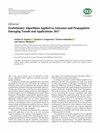A Compact Highly Isolated Four-Element Antenna System for Ultra-Wideband Applications
IF 1.1
4区 计算机科学
Q4 ENGINEERING, ELECTRICAL & ELECTRONIC
引用次数: 0
Abstract
A small, orthogonally polarized, ultra-wideband (UWB), four-port multiple-input multiple-output (MIMO) printed antenna is presented in this study. The envisioned antenna is built up of four microstrip fractal-based circular patch elements, each of which is fed by a microstrip line with a 50-ohm impedance. The use of a defective ground plane allows for the ultra-wideband frequency response to be obtained. In order to achieve maximal isolation, the amount of surface current that flow between the antenna’s four components is limited by arranging radiating elements orthogonally. The four-port MIMO system is printed on a FR4 substrate with a loss tangent of 0.02 and an overall dimension of 20 × 30 × 1.6 mm3. A port-to-port isolation of less than 25 dB was achieved as a consequence of this orthogonal orientation of antenna elements, and the impedance bandwidth is achieved up to 158% (3.1–12 GHz). The suggested ultra-wideband multiple-input multiple-output (UWB-MIMO) antenna achieved a maximum gain of 8 dBi over the operational frequency range (3.1–12 GHz); the findings that were measured and those that were simulated accord with one another rather well. The findings also give an overall strong diversity performance, with the ECC < 0.25, DG > 9.9, and CCL < 0.2 values all being within acceptable ranges.用于超宽带应用的紧凑型高隔离四元件天线系统
本研究介绍了一种小型、正交极化、超宽带 (UWB)、四端口多输入多输出 (MIMO) 印刷天线。设想中的天线由四个基于微带分形的圆形贴片元件组成,每个贴片元件由一条阻抗为 50 欧姆的微带线馈电。使用缺陷接地平面可获得超宽带频率响应。为了实现最大隔离度,通过正交排列辐射元件来限制天线四个元件之间的表面电流。四端口多输入多输出系统印制在损耗正切为 0.02、总尺寸为 20 × 30 × 1.6 mm3 的 FR4 基板上。由于天线元件的正交方向,端口与端口之间的隔离度小于 25 dB,阻抗带宽高达 158%(3.1-12 GHz)。所建议的超宽带多输入多输出(UWB-MIMO)天线在工作频率范围(3.1-12 GHz)内实现了 8 dBi 的最大增益;测量结果与模拟结果相当吻合。测量结果还显示出较强的总体分集性能,ECC <0.25、DG >9.9 和 CCL <0.2 值均在可接受范围内。
本文章由计算机程序翻译,如有差异,请以英文原文为准。
求助全文
约1分钟内获得全文
求助全文
来源期刊

International Journal of Antennas and Propagation
ENGINEERING, ELECTRICAL & ELECTRONIC-TELECOMMUNICATIONS
CiteScore
3.10
自引率
13.30%
发文量
158
审稿时长
3.8 months
期刊介绍:
International Journal of Antennas and Propagation publishes papers on the design, analysis, and applications of antennas, along with theoretical and practical studies relating the propagation of electromagnetic waves at all relevant frequencies, through space, air, and other media.
As well as original research, the International Journal of Antennas and Propagation also publishes focused review articles that examine the state of the art, identify emerging trends, and suggest future directions for developing fields.
 求助内容:
求助内容: 应助结果提醒方式:
应助结果提醒方式:


